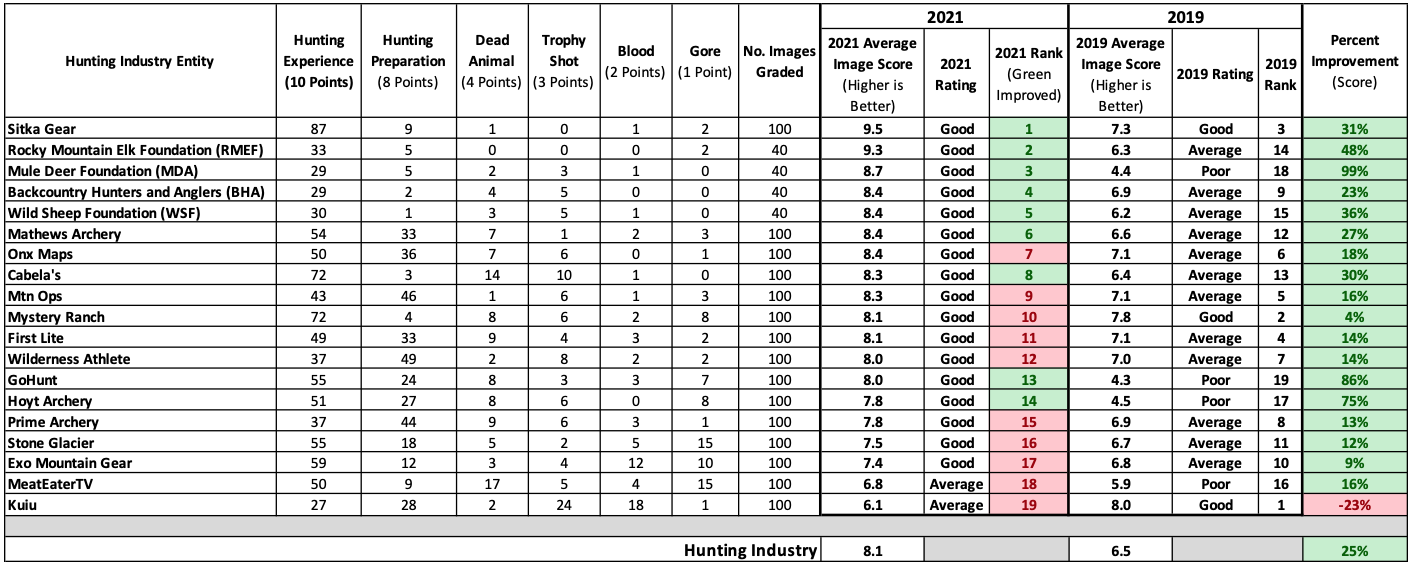Hunting Industry Improves the Quality and Taste of Instagram Posts
By Mountain Pursuit
In February 2019 Mountain Pursuit published a study, Grading Hunting Industry Instagram Posts from the Perspective of the Non-Hunter, which found that nearly 29% of images posted on social media by the hunting industry were trophy shots or photos with blood or gore—images that could damage public support for legal hunting.
This week, we re-graded the instagram accounts of the 19 hunting industry gear companies, media companies and non-profits. Overall, we found a score improvement of 25%.
The grading system used by Mountain Pursuit categorizes social media images into one of six categories and grades them accordingly: hunting experience, hunt preparation, dead animals, trophy shots, blood, or gore.
Here’s how the proportion of content changed between February 2019 and February 2021.
The proportion of beneficial image-types, images of hunting experiences or preparation, each increased, while the images that Mountain Pursuit argues damage public perception of hunting dropped substantially.
“This is major progress for the Industry and the future of pubic support for hunting,” Shaul says, “but the industry still has a long way to go.” Shaul argues that hunting gear and media companies are still the worst offenders, and need to work harder to clean-up free, public facing content.
As part of the 2019 study, Mountain Pursuit published Hunting Industry Social Media Guidelines:
(1) Post no "gore" images or videos.
"Gore" imagery includes kill shots, gutting, field dressing, stacks or rows of dead animals, bloody knives and bullets, fresh skinned skulls, etc. If the image is obscured and has a "sensitive content" warning, it should be immediately removed.
(2) Avoid all imagery that shows blood
(3) Minimize or eliminate typical "Trophy" shots.
These images position the hunter behind the animal, and have him or her looking directly at the camera. "Trophy" images portray the hunter as only concerned with his or her accomplishment, and not respectful of the animal he or she has harvested. While a strong majority (87%) support hunting for food, only 37% believe trophy hunting is acceptable.
(4) Replace typical "trophy" shots with images of the hunter looking at and admiring the harvested animal.
(5) Encourage imagery displaying hunt preparation including archery and firearm marksmanship practice, field scouting, fitness preparation, and gear preparation.
(6) Encourage imagery displaying the non-killing experience of the the hunt, including glassing, hiking, camping, natural wonder, stalking, hunter camaraderie, and camping.
(7) Post and advertise imagery guidelines, and carefully pre-screen any images submitted by posting by social media followers using the above criteria.
In addition to following the Hunting Industry Social Media Guidelines, Shaul challenges the Hunting Industry to require that all it's sponsored hunters take Mountain Pursuit's Protect the Hunt Pledge. "Those five simple tenants will go a long way toward reducing the risk of misperception and pressure on legal hunting," says Shaul.
This year, the overall hunting industry Instagram account improved by 25% over the 2019 results, and several industry companies and nonprofits made big moves in the rankings.
The Mule Deer Foundation made a 99% improvement and moved from #18 on the list to #2 in 2021, while Matthews Archery went from 14th overall to the #6 spot.
Meanwhile, some companies, like Kuiu, went from the #1 spot in 2019 to #19—dead last—in 2021. Notably, not a single company was rated as “poor” based on the tiers established in the original study. Here are the full results:
“These results better,” Shaul says, “but we will keep leading the industry to make the changes needed—average cant be good enough if we want our children to have a legal opportunity to hunt.”


